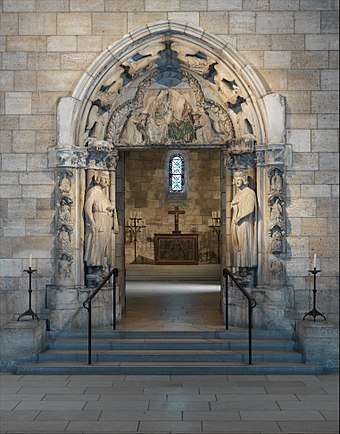Moutiers-Saint-Jean Abbey
Moutiers-Saint-Jean Abbey (from Latin monasterium sancti Johannis, French: Abbaye de Moutiers-Saint-Jean, also Abbaye Saint-Jean-de-Réome) was a monastery located in what is now the village of Moutiers-Saint-Jean (named after the monastery) in the Côte-d'Or department in eastern France. It is in Burgundy, near Dijon.

The monastery was founded by a monk named John around 450. In the seventh century, during the abbacy of Chunna (Hunnanus), a monk from Remiremont, the original monastic rule, which had been that of the ancient saint Macarius of Alexandria, was replaced by that of Luxeuil, founded by the Irish missionary Columbanus.[1] When Jonas of Bobbio stayed at the monastery in 659, during Chunna's abbacy, he was compelled by the monks to write a biography of their founder. The result was the Vita Iohannis.[1]
In 816–17, Saint-Jean was reformed according to the synods of Aachen. According to the record of monasteries made around that time, it owed the Carolingian state annually both a monetary gift (dona) and a military contribution (militia).[2]
The abbey became a major center of influence, by kings and nobles over the centuries; at one the time it was financed by the dukes of Burgundy.[3] Moutiers-Saint-Jean was sacked, burned and rebuilt a number of times; in 1567 the Huguenot army struck off the heads of the two kings on the main doorway.[4] In 1797, after the French Revolution, the entire building was sold as rubble for rebuilding. It lay in ruin for decades, with the sculpture severely defaced, before the Doorway from Moutiers-Saint-Jean was bought from the landowner and moved to New York in 1932, where it is now in The Cloisters museum.[5]
The remains of the abbey (the 14th-century main gate, the facades of two 17th-century buildings, the grounds of the abbey and the abbey church) are protected by the French government.[6]
Notes
- Fox 2014, pp. 97–98.
- Lesne 1920.
- Young, 78
- Little, 67
- Barnet, 70
- Mérimée PA00112565, Ministère français de la Culture. (in French)
Sources
- Barnet, Peter. The Cloisters: Medieval Art and Architecture. CT: Yale University Press, 2005. ISBN 978-1-5883-9176-6
- Diem, Albrecht (2008). "The Rule of an Iro-Egyptian Monk in Gaul: Jonas of Bobbio's Vita Iohannis and the Construction of Monastic Identity". Revue Mabillon. 80: 5–50.CS1 maint: ref=harv (link)
- Fox, Yaniv (2014). Power and Religion in Merovingian Gaul: Columbanian Monasticism and the Frankish Elites. Cambridge University Press.CS1 maint: ref=harv (link)
- Lesne, Émile (1920). "Les ordonnances monastiques de Louis le Pieux et la Notitia de servitio monasteriorum". Revue d'histoire de l'église de France. 6: 161–75, 321–38 and 449–93.CS1 maint: ref=harv (link)
- Little, Charles. "Set in Stone : The Face in Medieval Sculpture". New York: Metropolitan Museum of Art, 2006. ISBN 978-1-5883-9192-6
- Young, Bonnie. A Walk Through The Cloisters. New York: Viking Press, 1979. ISBN 978-0-8709-9203-2